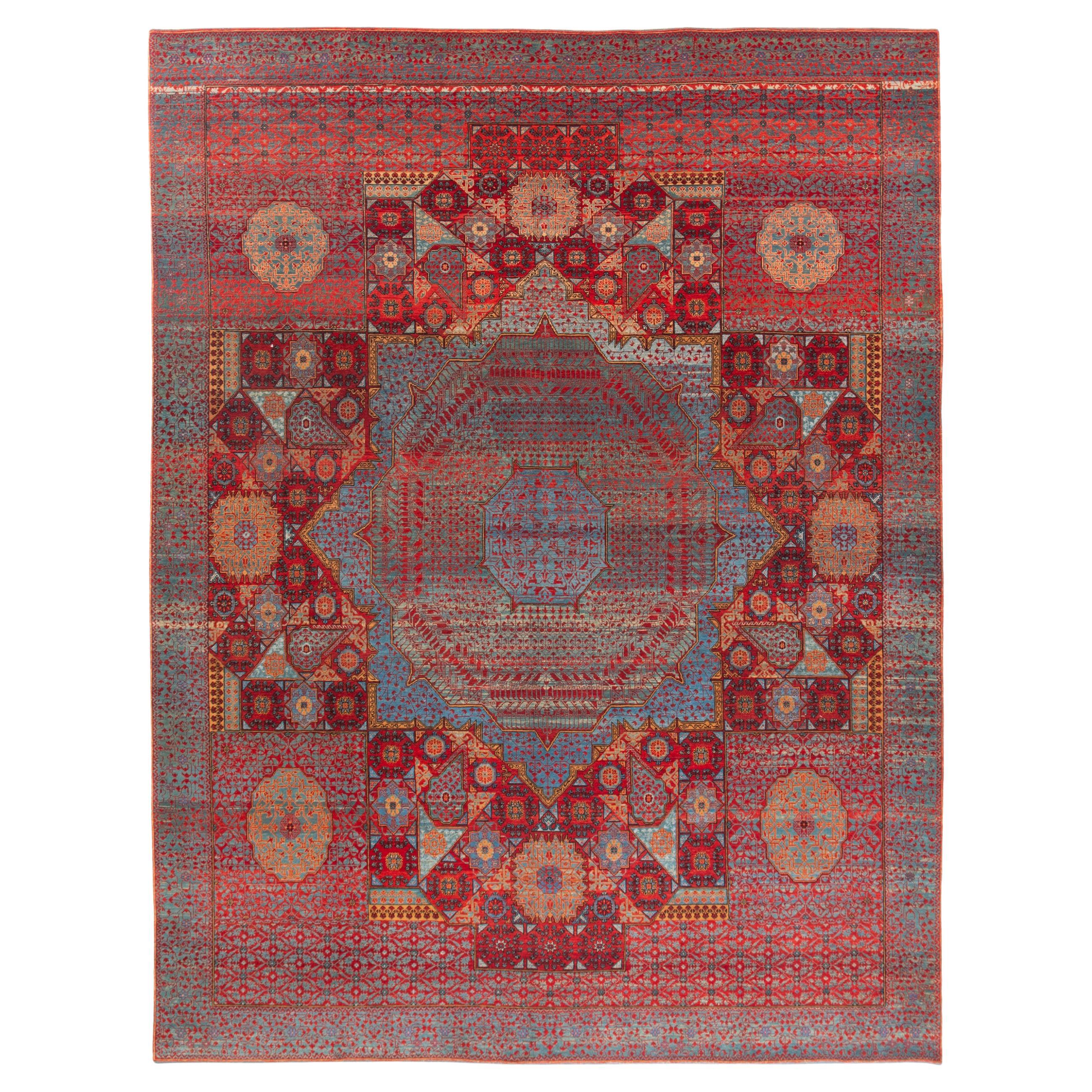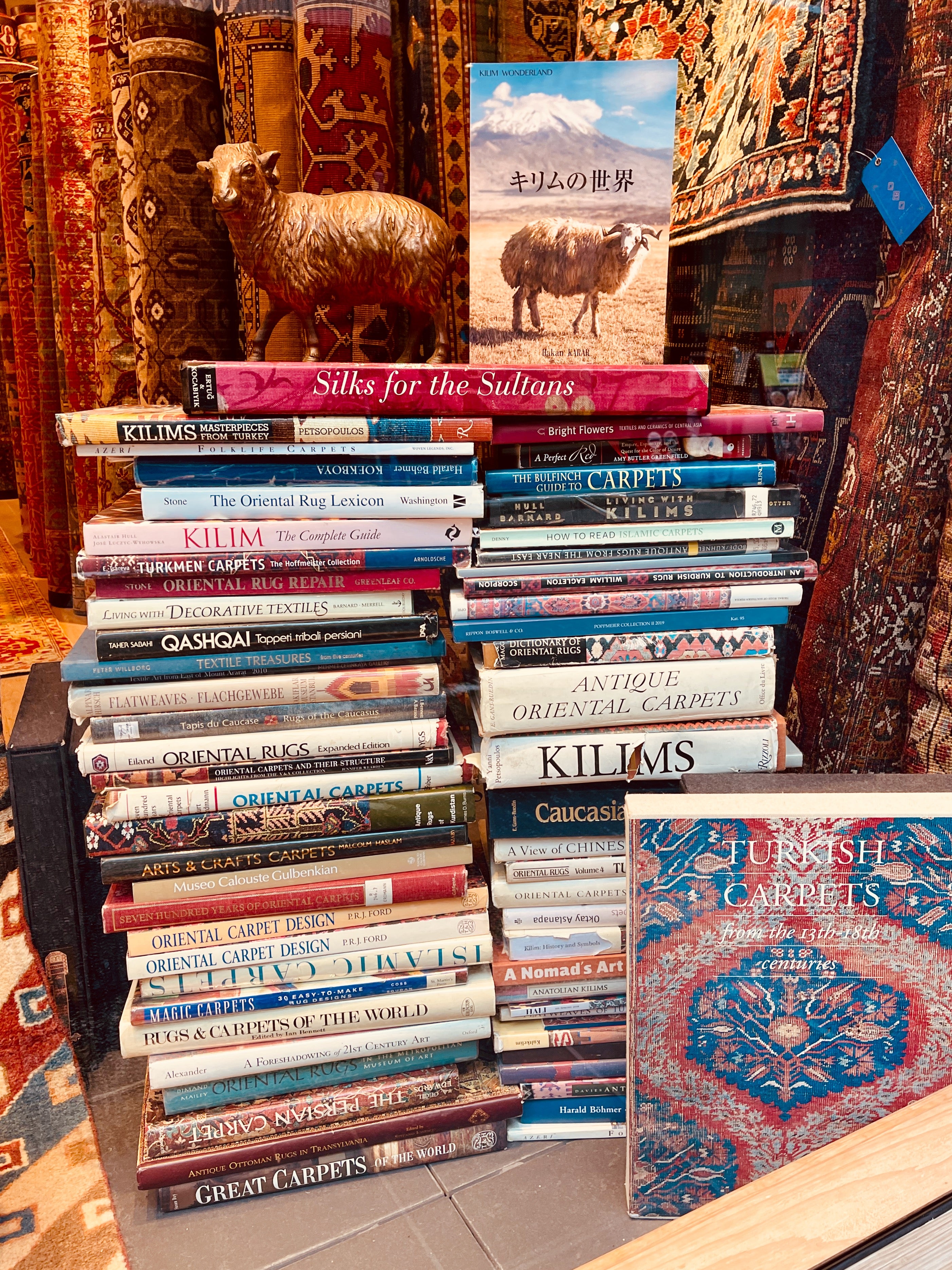Items Similar to Ararat Rugs Mamluk Rug with Central Star, 16th C. Revival Carpet, Natural Dyed
Want more images or videos?
Request additional images or videos from the seller
1 of 6
Ararat Rugs Mamluk Rug with Central Star, 16th C. Revival Carpet, Natural Dyed
About the Item
The source of the rug comes from the Textile Museum, Washington D.C. inv. R 16.2.4. This rug with the central star was designed in the early 16th-century rug by Mamluk Sultane of Cairo, Egypt. Acquired by Mr.Myers at the 1926 Benguiat Sale(“a Damascus Gothic Carpet”) and exhibited at the 1947 Chicago Exhibition, this carpet breaks with the usual standard format. Not long enough for a 3 medallion carpet, the field has been elongated between the Elem and the central medallion.
Attempting to read early carpets produced in workshops in Cairo provides an entirely different set of challenges. Cairene carpets, distinguished by their limited color palette, symmetrical knotting, and unusual construction of S-spun wool (Z-spun wool being the norm almost everywhere in the Islamic world), underwent a sudden change in design sometime after the Ottoman Turks conquered the Mamluk empire in 1517. The Simonetti Carpet was probably woven after the conquest but exhibits the “old” 15th-century style of the Mamluks. Long and narrow, it was woven on a standard-sized Egyptian roller-beam loom, capable of producing carpets of varying lengths. It consists of five major focal areas of design in an A-B-C-B-A pattern, meaning the first and fifth and the second and fourth areas are paired, while the middle is unique. We can easily term these five focal areas medallions, but they are geometric in both layout and detail, and their style (as opposed to the actual date of the weaving) predates the carpet design revolution that gave rise to the medallion format. We can surmise that the designs and colors of Mamluk carpets, with their unusual combination of insect-derived red, blue, green, and sometimes yellow, with virtually no undyed white at all, constitute an effort to create a recognizable brand in the early modern market, especially in Europe, where Mamluk carpets such as this, with their subtle coloration, incredibly detailed design, and mosaic-like layout of small and intricately patterned geometric motifs, constituted an appealing alternative to the more coarsely woven and brightly colored carpets from Anatolia, such as Ushak medallion carpets. While the weaving of carpets in the traditional geometric Mamluk designs apparently continued well into the seventeenth century, sometime around the mid-sixteenth century, Cairene weavers began to create an entirely new kind of carpet, using their traditional Mamluk materials, technique, and coloration but reflecting the latest styles then being created at the court of the Ottoman sultans in Istanbul. The design of the rug is interpreted by our designers, and soft colors are used for this rug.
Color summary: 4 colors in total;
Imperial red 415 (Madder Root)
Emerald green 407 (Chamomile – Indigo)
Cadet blue 26 (Indigo – Spurge)
Sunray color 405 (Henna)
Group: Islamic Rugs Family
Area: Mamlouk
Material of Pile: Natural dyed hand-spun wool
Material Warp / Weft: Wool on Wool
Structure: Symmetrical knot on depressed warp inclining to the right
Knots Density: 39x39
Production Place: Southeastern Anatolia - Harran
Stock Location: Tokyo
Size (EU): 202 X 284cm
Size (US): 6'7" X 9'3"
Area (EU): 5.7m²
Area (US): 61.8ft²
- Creator:Ararat Rugs (Manufacturer)
- Dimensions:Width: 79.53 in (202 cm)Length: 111.82 in (284 cm)
- Style:Revival (In the Style Of)
- Materials and Techniques:
- Place of Origin:
- Period:
- Date of Manufacture:2022
- Production Type:New & Custom(One of a Kind)
- Estimated Production Time:Available Now
- Condition:
- Seller Location:Tokyo, JP
- Reference Number:1stDibs: LU8206233002442
ARARAT RUGS
We know and believe that the geography we come from, our past, and our lifestyle are the most important bond between us to carry the oriental carpet art and culture to the next generations along with our core values in our ongoing growth journey.
We are aware that the way to achieve this goal and carry this priceless art and culture to the future depends on a lot of work with all our people every day while adhering to our core values.
For us, art is meaningful in the sense that it brings together various cultures around the world. It is an honor for us that oriental carpet art and culture have been instrumental in this for centuries and that we are a part of this business.
We are tirelessly keeping an eye on auction house information around the world about carpets. New York's Metropolitan, London's Victoria & Albert Museums, and other famous art museums, as well as small specialized museums that house private collections, and books about oriental carpets to collect information on outstanding carpet designs and patterns from around the world. It's our Self-improving and Self-developing culture.
As Turkish Culture of Hospitality, the Kurdish Culture of Generosity, and as Japanese Culture of Business Punctuality; are the most important values that this multicultural background has taught and bequeathed to us. It is essential and valuable for us that you feel this feeling not only by looking at our oriental carpets but from the moment you contact us.
About the Seller
5.0
Gold Seller
These expertly vetted sellers are highly rated and consistently exceed customer expectations.
Established in 1970
1stDibs seller since 2023
12 sales on 1stDibs
Typical response time: 1 hour
- ShippingRetrieving quote...Ships From: Tokyo, Japan
- Return PolicyA return for this item may be initiated within 7 days of delivery.
More From This SellerView All
- Ararat Rugs Mamluk Carpet with Central Star 16th Century Revival, Natural DyedBy Ararat RugsLocated in Tokyo, JPThe source of the rug comes from the book Völker, Angela, Die orientalischen Knüpfteppiche das MAK, Vienna: Böhlau, 2001: 42–5. This rug with the central star was designed in the early 16th-century rug by Mamluk Sultane of Cairo, Egypt. It is exhibited at MAK – Museum of Applied Arts, Vienna Austria. As its impressive size, materials, and design quality suggest, the carpet is a product of an accomplished court workshop and likely dates from the late period of the last Mamluk dynasty. The quantity of the colors used speaks for an earlier date around 1500; the delicate vegetal border with leaf tendrils and the characteristic umbrella leaves...Category
21st Century and Contemporary Turkish Revival Turkish Rugs
MaterialsWool, Natural Fiber, Organic Material
- Ararat Rugs Mamluk Carpet with Central Star 16th Century Revival, Natural DyedBy Ararat RugsLocated in Tokyo, JPThe source of the rug comes from the book Völker, Angela, Die orientalischen Knüpfteppiche das MAK, Vienna: Böhlau, 2001: 42–5. This rug with the central star was designed in the early 16th-century rug by Mamluk Sultane of Cairo, Egypt. It is exhibited at MAK – Museum of Applied Arts, Vienna Austria. As its impressive size, materials, and design quality suggest, the carpet is a product of an accomplished court workshop and likely dates from the late period of the last Mamluk dynasty. The quantity of the colors used speaks for an earlier date around 1500; the delicate vegetal border with leaf tendrils and the characteristic umbrella leaves...Category
21st Century and Contemporary Turkish Revival Turkish Rugs
MaterialsWool, Natural Fiber, Organic Material
- Ararat Rugs Mamluk Carpet with Central Star 16th Century Revival, Natural DyedBy Ararat RugsLocated in Tokyo, JPThe source of the rug comes from the book Völker, Angela, Die orientalischen Knüpfteppiche das MAK, Vienna: Böhlau, 2001: 42–5. This rug with the central star was designed in the early 16th-century rug by Mamluk Sultane of Cairo, Egypt. It is exhibited at MAK – Museum of Applied Arts, Vienna Austria. As its impressive size, materials, and design quality suggest, the carpet is a product of an accomplished court workshop and likely dates from the late period of the last Mamluk dynasty. The quantity of the colors used speaks for an earlier date around 1500; the delicate vegetal border with leaf tendrils and the characteristic umbrella leaves...Category
21st Century and Contemporary Turkish Revival Turkish Rugs
MaterialsWool, Natural Fiber, Organic Material
- Ararat Rugs Mamluk Carpet with Central Star 16th Century Revival - Natural DyedBy Ararat RugsLocated in Tokyo, JPThe source of the rug comes from the book Völker, Angela, Die orientalischen Knüpfteppiche das MAK, Vienna: Böhlau, 2001: 42–5. This rug with the central star was designed in the early 16th-century rug by Mamluk Sultane of Cairo, Egypt. It is exhibited at MAK – Museum of Applied Arts, Vienna Austria. As its impressive size, materials, and design quality suggest, the carpet is a product of an accomplished court workshop and likely dates from the late period of the last Mamluk dynasty. The quantity of the colors used speaks for an earlier date around 1500; the delicate vegetal border with leaf tendrils and the characteristic umbrella leaves...Category
21st Century and Contemporary Turkish Revival Turkish Rugs
MaterialsWool, Natural Fiber, Organic Material
- Ararat Rugs Mamluk Rug with Central Star 16th Cent. Revival Carpet Natural DyedBy Ararat RugsLocated in Tokyo, JPThis rug with the central star was designed in the early 16th-century rug by Mamluk Sultane of Cairo, Egypt. Attempting to read early carpets produced in workshops in Cairo provides ...Category
21st Century and Contemporary Turkish Revival Turkish Rugs
MaterialsWool, Natural Fiber, Organic Material
- Ararat Rugs Mamluk Rug with Central Star 16th Cent. Revival Carpet Natural DyedBy Ararat RugsLocated in Tokyo, JPThis rug with the central star was designed in the early 16th-century rug by Mamluk Sultane of Cairo, Egypt. Attempting to read early carpets produced in workshops in Cairo provides ...Category
21st Century and Contemporary Turkish Revival Turkish Rugs
MaterialsWool, Natural Fiber, Organic Material
You May Also Like
- Star Kazak Original 16th Century Style Flatweave Rug by Knots RugsLocated in London, GBCOLOUR: Original MATERIAL: 100% Wool QUALITY: 23 x 39 Persian knot / inch ORIGIN: Persian knotted rug produced in Afghanistan RUG SIZE DISPLAYED: 128cm x 191cm Inspired by an or...Category
21st Century and Contemporary Afghan Turkish Rugs
MaterialsWool
- Vintage Over-Dyed Grey Rug Carpet Oriental Wool Area RugLocated in Hampshire, GBThis distressed over-dyed rug is one of the best choices as Home decor objects. This grey rug has been distressed and over-dyed to achieve a contemporary, worn piece. This unique pie...Category
Vintage 1950s Pakistani Revival Turkish Rugs
MaterialsWool, Cotton, Organic Material
- Carpet with the pattern of ancient Mamluk carpets and light shadeLocated in Firenze, ITImportant contemporary production carpet made entirely by hand in Turkey, which is inspired by the famous "Mamluk" carpets. Mamluks are called Egyptian-made carpets, probably from Ca...Category
2010s Turkish Moorish Turkish Rugs
MaterialsWool
- Handmade Turkish Tulu Rug, 100% Natural Un-Dyed Wool, Modern Scandinavian CarpetLocated in Philadelphia, PA100% Natural Hand-Spun Wool of finest quality. These hand-knotted rugs are produced from scratch in our atelier located in Central Anatolia, famous for being one of the world's olde...Category
2010s Turkish Tulu Turkish Rugs
MaterialsWool
- Natural Dye Mamluk Revival RugBy Mehraban RugsLocated in WEST HOLLYWOOD, CAA classic revival of Mamluk rug is phenomenal with traditional style. An oversized rug that has neutral colors of sepia. Medallions and blooming ornaments are symmetrically aligned a...Category
21st Century and Contemporary Afghan Central Asian Rugs
MaterialsWool
- Rare 16th Century Cairene RunnerLocated in New York, NYAuthentic 16th century Cairene runner Size: 3'0" × 13'1" (91 × 398 cm) A 16th century Cairene antique runner, the abrashed dusty rose field with stylized leaves and rosettes overall around a column of cusped medallions with crosses at each end and containing a floral branch within an ivory rosette border. Woven in Egypt under imperial Ottoman...Category
Antique 16th Century Egyptian Turkish Rugs
MaterialsWool






